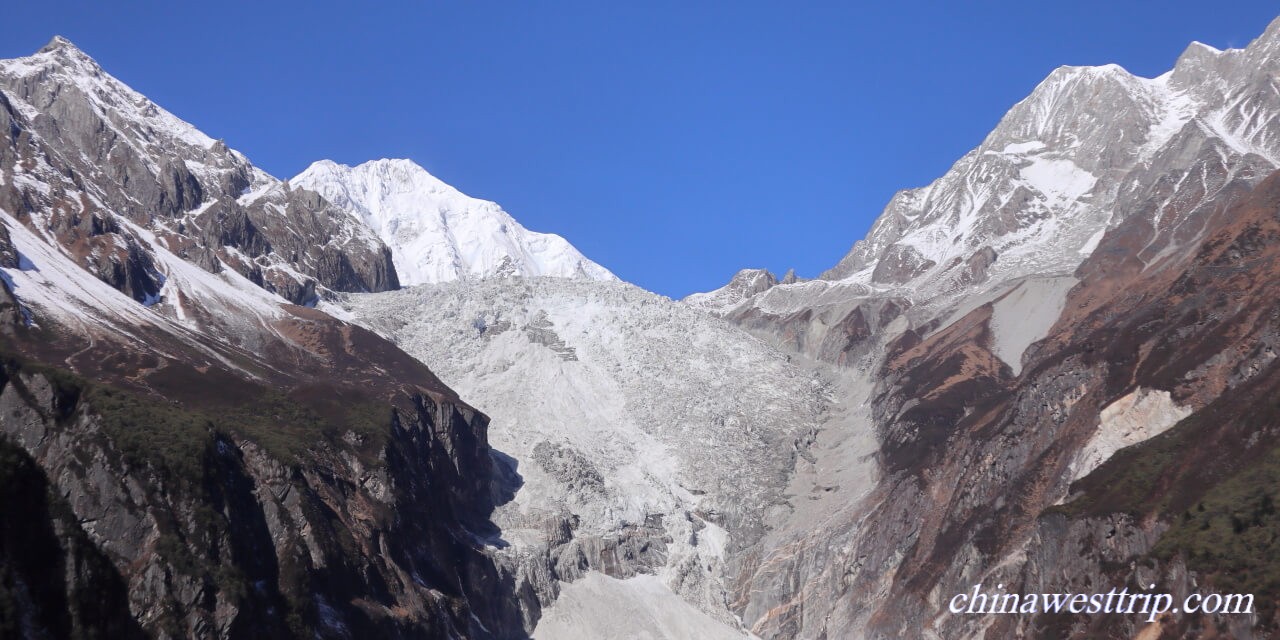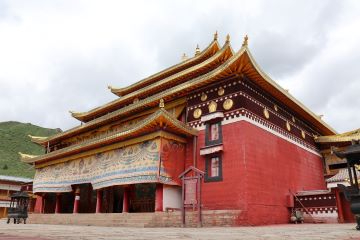Mount Minya Konka

Name in Chinese: 海螺沟 Hǎi Luó Gōu [hai lɔ: gəu]
Duration of Tour: Six Hours
Location: Luding County, Garze Tibetan Autonomous Prefecture, Sichuan Province
Highlights: Photography, Hiking, the Glacier, Snow-capped Mountains, Virgin Forests and Tibetan and Yi Culture
Must-see Sightseeing Spots: the No.4 Camping Site, Caohaizi Wetland, the Hot Spring and Moxi Ancient Town
Reputations: A National Forrest and Glacier Park, A National Gee-park, A State-level Nature Reserve, A National Five-star Scenic Area
Hailuogou National Glacier and Forest Park is a collection of wondrous glacier, virgin forests, snow-capped mountains, hot springs, wild animals and plants. The glacier lies on the east slope of Mount. Minya Konka(or Gongga Mountain in Chinese). Minya Konka is 7,556 meters(24,790 feet) above sea level, is the highest mountain in Sichuan Province. The glacier in Hailuogou Valley is 14.7 km(9.13 miles) in length, covering an area of 16 square kilometers(3,954 acres). Formed 16 million years ago, it is classified as a globally rare modern glacier with the lowest point at 2,850 meters(9,350 feet) above sea level. Compared with other glaciers in the world, most of which are located in high and cold, remote and deserted regions, Hailuogou Glacier is more accessible, closer to the urban area, and easier to climb, even suitable for the elderly. The Great Frozen Waterfall is a 1,080-meter(3,543-foot) drop, half a meter(1.64 feet) to 1,100 meters(3,609 feet) in width. It is the largest in China.
Hailuogou Valley lies at the foot of Mount. Minya Konka. Its climatic and ecological environment is unique due to its special geographical location. The altitude of the valley ranges from 1,940 meters(6,365 feet) to 3,600 meters(11,811) above the sea level. The weather in the valley vertically varies. A saying goes that four seasons coexist in one valley, and the weather differs over a distance of five kilometers. As a result, the vegetation in the valley is rich and varies at different altitudes, namely, evergreen, broad-leaf trees, mixed woods of deciduous and broad-leaf trees, coniferous trees mixed with broad-leaf trees, coniferous forest, highland bush and grassland. Within an area of 70 square kilometers(17,297 acres), there are over 5,990 kinds of plants, sixteen of which are state-level rare plants under protection. The valley is also an ideal sanctuary of animals and birds. According to a preliminary investigation, there are 60 species of mammals, 266 birds, 22 reptiles, 14 amphibians. Among those creatures, thirty nine are state-level rare species under protection, such as antelope, macaque, red panda, leopard, etc.
Hailuogou Valley is inhabited by Tibetans and Yi people. They both maintain their own traditions and life style. The entrance of the park is set at Moxi Town. The town was built centuries ago. It used to be a very important post station on the Ancient Tea and Horse Path. It is 1,580 meters(5,184 feet) above sea level. It is an ideal place for visitor to stay overnight.
The attractions of Hailuogou Valley include the glacier, the summit of Mount. Minya Konka, the virgin forests, the hot spring and the minorities’ folk customs. The major sightseeing spots are the No.4 Camping Site, Caohaizi Wetland, Moxi Ancient Town and the Hot Spring.
The No.4 Camping Site
The No.4 Camping Site is located on the top of the valley, 3,600 meters(11,811 feet) above sea level. It is the best place to view the glacier, the Great Frozen Waterfall and the summit of Minya Konka. Visitors need to take cable cars to get to the No.4 Camping Site from the No.3 Camping Site.
The Glacier
The Glacier is called the No.1 Glacier of Hailuogou Valley. It is 14.7 km(9.13 miles) in length, covering an area of 16 square kilometers(3,954 acres). The glacier was formed 16 million years ago. It is classified as a globally rare modern glacier at low altitude. The altitude of the glacier ranges from 2,850 meters(9,350 feet) to 6,750 meters(22,146 feet) above sea level. There are three major glaciers in the valley. The No.1 Glacier is the longest, the most marvelous and magnificent among the three glaciers. It moves downwards one and a half meters a year. The glacier contains blueish ice and shattered rocks. The surface of the glacier is fractured and folded with splits, holes and crevasses.
Mount Minya Konka
Mount Minya Konka is called Gongga Mountain in Chinese. In fact, Gongga is a Tibetan word. Gong means ice and Ga means white. It is known to locals as the king of mountains in Sichuan Province. Minya Konka is situated in Daxueshan Mountain Range, a part of Hengduan Mountain Range, is the highest peak in Sichuan Province. The summit is 7,556 meters(24,790 feet) above sea level, is the easternmost 7,000-meter(22,966-foot) peak in the world, the third highest outside Himalaya and Karakoram. In 1932, an American team started their mountaineering expedition from the west side of the mountain, and climbed the northwest mountain ridge. There were four members in the team. They were Terris Moore, Richard Burdsall, Arthur B. Emmons and Jack T. Young. Only two of them succeeded in climbing to the summit. It was a remarkable achievement at that time, considering the height of mountain, the remoteness of expedition, and the small size of the team. However, Minya Konka has earned a reputation as one of the top three mountains difficult and dangerous for people to climb. It is reported that the mountain has been successfully climbed only nine times so far, totally 24 climbers reached the summit, 37 never returned home.
The Great Frozen Waterfall
The Great Frozen Waterfall hangs on the top of the No.1 Glacier. It is the largest in China. The frozen waterfall is 1,080 meters(3,543 feet) in height, half a meter(1.6 feet) at its narrowest, and 1,100 meters(3,609 feet) at its widest.
The Arch-gate-like Ice Path and the Moon Lake
At the end of the glacier, there is a big crevasse. It looks like an arch gate in city walls. It is a place where visitors can touch the glacier. The Moon Lake is an ideal place for photographers to view the golden summit with its reflection on the water.
Caohaizi Wetland
In fact, Caohaizi Wetland is a moraine-dammed lake, which covers an area of 5,000 square meters(1.24 acres). It is 2,850 meters(9,350 feet) above sea level. The lake is surrounded by virgin forest. A path leads to the lake from the bus stop. The air is fresh, and the oxygen content is quite high.
Moxi Ancient Town
Moxi Ancient Town is located at the entrance gate of the park. Its altitude is 1,580 meters(5,184 feet) above sea level. There is a Catholic church in the town. It was built by a french missionary in 1918. In May, 1935, the Red Army arrived at the town, and Chairman Mao stayed overnight in the church.
The Hot Spring
The hot spring in the midst of ice and snow brings visitors great pleasure. The temperature is over 80℃(170°F). The mineral water is free of harmful elements,safe and suitable for medical treatment. It is quite enjoyable to soak in a hot-spring bath after hiking for hours.
Travel Tips
How to Get to Hailuogou Glacier and Forest Park
Hailuogou Glacier and Forest Park is located in Luding County, Garze Tibetan Autonomous Prefecture, Sichuan Province. The town near the entrance gate is Moxi Town. It is 277 km(172 miles) away from Chengdu, 104 km(65 miles) from Kangding, and 50 km(31 miles) from Luding. It takes about four hours to get to Hailuogou Valley from Chengdu by a car, two and a half hours from Kangding, and one hour from Luding.
How to Visit Hailuogou Glacier and Forest Park
Sightseeing buses shuttle between the entrance and the No.3 Camping Site. Visitors can take cable cars from the No.3 Camping Site to the No.4 Camping Site to view the summit of Mount. Minya Konka, the Great Frozen Waterfall and the glacier. A path leads to the Moon Lake from the No.3 Camping Site. The path is one and half Kilometers in total length. Then, take the sightseeing shuttle buses down to Hailuo Lamasery Bus Stop, walk along the path into the virgin forest to visit Caohaizi Lake. Afterwards, ride the shuttle buses to the entrance gate.
Weather
In the mountainous areas, the frequency of foggy weather is quite high. But some people believe that fog is also an essential beauty of Hailuogou Valley. When the fog begins to disperse in the morning, it is more likely to view the sea of clouds. It is a fantastic beauty only existing in the fairyland.
The temperature in Hailuogou Glacier Park ranges from minus 12℃(10.4°F) in January to 22℃(71.6°F) in August. The best time to visit Hailuogou Valley is between September and October. Visitors should try to avoid going to Hailuogou Valley in the rainy season. The rainy season in Sichuan lasts from July to August.
Because the altitude is high, visitors should prepare warm coat and try to decrease the risk of catching a cold, even in the summer.
Lunch
There is a restaurant at the No.3 Camping Site. It is called the Golden Mountain Restaurant. It offers visitors local dishes and hot tea.
How to Avoid Altitude Sickness
The altitude of Hailuogou Valley ranges from 2,850 meters(9,350 feet) to 3,600 meters(11,811) above sea level. The highest sightseeing spot visitors can reach is 3,600 meters(11,811) above sea level. Visitor should try to avoid the AMS. Please read more about AMS.
Photography Tips
A tripod, a filter, telephoto lenses and wide angle lenses are needed.
The scenic area opens at 7:00 A.M. in summer, and 8:00 A.M. in winter. Photographers should try to get to the No.4 Camping site before 10:30 A.M. in sunny days. The Moon Lake is considered as the best place for photographers to take photos of the golden summit under the sunset, but they have to spend the night at the Camp No.3.
Recommended Tour:
Twelve-Days West Sichuan Pure Land and Tibetan Culture Exploring Tour
Fifteen-day Sichuan Photography Tour
Related Articles:
Daocheng Yading
Siguniang Mountain
Altitude Sickness
Author: Tina Luo
Update:
